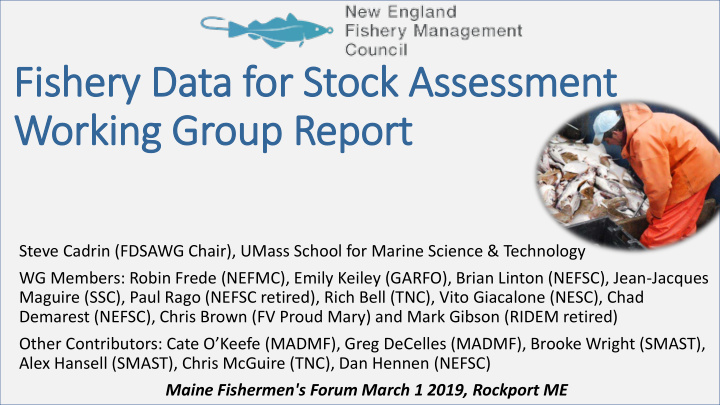



Fishery Data for Stock Assessment Working Group Report Steve Cadrin (FDSAWG Chair), UMass School for Marine Science & Technology WG Members: Robin Frede (NEFMC), Emily Keiley (GARFO), Brian Linton (NEFSC), Jean-Jacques Maguire (SSC), Paul Rago (NEFSC retired), Rich Bell (TNC), Vito Giacalone (NESC), Chad Demarest (NEFSC), Chris Brown (FV Proud Mary) and Mark Gibson (RIDEM retired) Other Contributors: Cate O’Keefe (MADMF), Greg DeCelles (MADMF), Brooke Wright (SMAST), Alex Hansell (SMAST), Chris McGuire (TNC), Dan Hennen (NEFSC) Maine Fishermen's Forum March 1 2019, Rockport ME
Background • Amendment 23 to the Multispecies Fishery Management Plan • to implement measures to improve reliability and accountability of catch reporting and to ensure a precise and accurate representation of catch (landings and discards). • www.nefmc.org/library/amendment-23
Fishery ry Data for Stock Assessment • Background • Deliverables 1. how fishery-dependent and fishery- independent data are used in stock assessments. 2. utility and limitations of fishery catch rate as an index of abundance for Northeast Multispecies stocks. 3. fishery factors and fishery-dependent data needed for a reliable CPUE index 4. desired factors and existing conditions • Recommendations
How fi fishery ry-dependent and fi fishery-independent data are used in stock assessments • Population models are fit to the available fishery and fishery- independent data to estimate a time series of stock abundance, age structure and fishing mortality. 1. A time series of total fishery removals is derived from several fishery monitoring programs (commercial landings, commercial discards, recreational landings, and recreational discards) 2. Fishery-independent surveys or fishery catch rates provide indices of relative stock abundance 3. Size or age composition of the stock and of the fishery
The times series of fishery removals is used in the stock assessment for: 1. minimum stock sizes 2. amount of sustained productivity. Fishery Catch (tons) The assessment also accounts for some natural mortality and survival each year based on age composition and stock abundance indices. NEFSC (2013)
Fishery Age Composition Survey Age Composition Lower Lower Survival Survival Weaker Recruitment Higher Higher Survival Survival Stronger Recruitment NEFSC (2013)
NEFSC (2013)
NEFSC (2013)
Catch Rate Catch Rate Catch Rate NEFSC (2013)
2013 White Hake Benchmark Assessment • Fishery catch rate indices were not expected to perform well because of management changes affecting effort. Port interviews Logbooks International Total WGOM & Cashes A Allowable Catch closures C L Input Controls / to S Days at Sea for End Overfishing e ‘Optimum Yield’ c t o r
Using CPUE as an In Index of f Abundance • Fishery catch rates (CPUE) are used in many stock assessment models as an index of stock abundance. • These assessments assume that catch rates are proportional to stock abundance, which is not always true. • Fisheries are not designed to representatively sample a fish population, so trends in catch rates may not reflect trends in the stock. • Fishery catch rates can be standardized to account for factors like changing patterns in fishing area, fishing season, or vessel characteristics, but some factors cannot be effectively standardized. NEFSC 2018 Recreational CPUE 1990 2000 2010
Considering CPUE in a Stock Assessment • Even if it is not used in the stock assessment model, fishery data can provide information with high spatial and temporal resolution to help to understand fishery dynamics. • Including fishery perceptions may also improve the acceptance of stock assessment results by the fishing industry. Appendix 6. Fishers’ North Sea Stock Survey
Primary ry Recommendations • Routinely consider fishery catch rates as an index of abundance in peer-reviewed stock assessments, not necessarily accepted as an index of abundance in the final stock assessment model. • Identifying best practices for standardizing fishery catch rates for all groundfish stocks. • Consider study fleets, at-sea observer data, advanced technologies (e.g., electronic monitoring systems), targeted fishing effort and appropriate units of fishing effort. • Processes for soliciting fishermen’s expertise for understanding factors of catch rates, fishing patterns, and targeting or avoidance behavior should be included in the stock assessment process such as workshops and questionnaires.
Recommend
More recommend